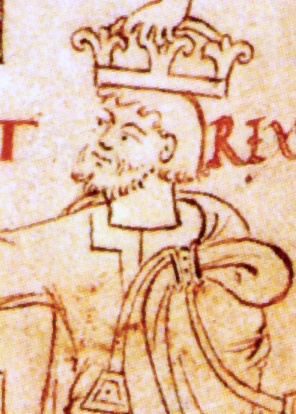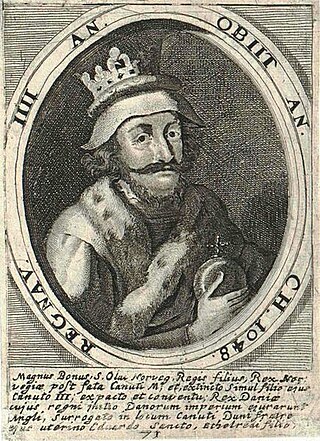Contents
This article needs additional citations for verification .(February 2024) |
11th century in Denmark |
| Other centuries |
| 10th century | 11th century | 12th century |
Events from the 11th century in Denmark.
This article needs additional citations for verification .(February 2024) |
11th century in Denmark |
| Other centuries |
| 10th century | 11th century | 12th century |
Events from the 11th century in Denmark.
Date unknown
Date unknown
Godwin of Wessex was an English nobleman who became one of the most powerful earls in England under the Danish king Cnut the Great and his successors. Cnut made Godwin the first Earl of Wessex. Godwin was the father of King Harold II and of Edith of Wessex, who in 1045 married King Edward the Confessor.

Emma of Normandy was a Norman-born noblewoman who became the English, Danish, and Norwegian queen through her marriages to the Anglo-Saxon king Æthelred the Unready and the Danish king Cnut the Great. A daughter of the Norman ruler Richard the Fearless and Gunnor, she was Queen of the English during her marriage to King Æthelred from 1002 to 1016, except during a brief interruption in 1013–14 when the Danish king Sweyn Forkbeard occupied the English throne. Æthelred died in 1016, and Emma married Sweyn's son Cnut. As Cnut's wife, she was Queen of England from their marriage in 1017, Queen of Denmark from 1018, and Queen of Norway from 1028 until Cnut died in 1035.

Harthacnut, traditionally Hardicanute, sometimes referred to as Canute III, was King of Denmark from 1035 to 1042 and King of the English from 1040 to 1042.

Sweyn Forkbeard was King of Denmark from 986 until his death, King of England for five weeks from December 1013 until his death, and King of Norway from 999/1000 until 1013/14. He was the father of King Harald II of Denmark, King Cnut the Great, and Queen Estrid Svendsdatter.

Cnut, also known as Canute and with the epithet the Great, was King of England from 1016, King of Denmark from 1018, and King of Norway from 1028 until his death in 1035. The three kingdoms united under Cnut's rule are referred to together as the North Sea Empire by historians.

Magnus Olafsson, better known as Magnus the Good, was King of Norway from 1035 and King of Denmark from 1042 until his death in 1047.

Sweyn Estridsson Ulfsson was King of Denmark from 1047 until his death in 1076. He was the son of Ulf Thorgilsson and Estrid Svendsdatter, and the grandson of Sweyn Forkbeard through his mother's line. He was married at least two times, and fathered 20 children or more out of wedlock, including the five future kings Harald Hen, Canute the Saint, Oluf Hunger, Eric Evergood, and Niels.

Canute IV, later known as Canute the Holy or Saint Canute, was King of Denmark from 1080 until 1086. Canute was an ambitious king who sought to strengthen the Danish monarchy, devotedly supported the Roman Catholic Church, and had designs on the English throne. Slain by rebels in 1086, he was the first Danish king to be canonized. He was recognized by the Roman Catholic Church as patron saint of Denmark in 1101.

Olaf I, nicknamed Olaf Hunger, was king of Denmark from 1086 to 1095, following the death of his brother Canute IV the Holy. He was a son of king Sweyn II Estridsson, and the third of Sweyn's sons to rule. He married Ingegard, the daughter of Harald Hardråde, but did not have any sons. He was succeeded by his brother Eric the Good.

Harald Svendsen was King of Denmark from 1014 until his death in c. 1018. He was the youngest son of Sweyn Forkbeard and Gunhild of Wenden, and was regent while his father was fighting Æthelred the Unready in England. He inherited the Danish throne in 1014, and held it while his brother, the later king Cnut the Great conquered England. After his death in 1018(?), he was succeeded by Cnut the Great. Little detail is known about Harald II.

Harald Hen was King of Denmark from 1076 to 1080. Harald III was an illegitimate son of Danish king Sweyn II Estridsson, and contested the crown with some of his brothers. He was a peaceful ruler who initiated a number of reforms. Harald was married to his cousin Margareta Hasbjörnsdatter, but did not leave any heirs, and was succeeded by his brother Canute IV the Saint. Four of his half-brothers were in turn crowned Danish kings.
The Sandur hoard of the Faroe Islands was found in Sandur in 1863 and consists of 98 medieval silver coins, which were probably buried between 1070 and 1080. The hoard is the oldest and only coin hoard found on the archipelago.
Events from the 1010s in England.

Estrid Svendsdatter of Denmark, was a Danish princess and titular queen, a Russian princess and, possibly, duchess of Normandy by marriage. She was the daughter of Sweyn Forkbeard and perhaps Gunhild of Wenden and half-sister of Cnut the Great. By Ulf Jarl, she was the mother of the later King Sweyn II Estridson and Beorn Estrithson. The dynasty that ruled Denmark in 1047–1412 was named after her. Though never a ruler or wife of a king, she was known in Denmark as queen during her son's reign.

The North Sea Empire, also known as the Anglo-Scandinavian Empire, was the personal union of the kingdoms of England, Denmark and Norway for most of the period between 1013 and 1042 towards the end of the Viking Age. This ephemeral Norse-ruled empire was a thalassocracy, its components only connected by and dependent upon the sea.

The House of Estridsen was a dynasty that provided the kings of Denmark from 1047 to 1412. The dynasty is named after its ancestor Estrid Svendsdatter. The dynasty is sometimes called the Ulfinger, after Estrid's husband, Ulf Jarl. The dynasty also provided three medieval rulers of Sweden and one of Norway. Their family coat of arms became the coat of arms of Denmark and therefore influenced the coat of arms of Tallinn and the coat of arms of Estonia.
Canute of Denmark - Danish: Knud - may refer to:

The Danish House of Knýtlinga was a ruling royal house in Middle Age Scandinavia and England. Its most famous king was Cnut the Great, who gave his name to this dynasty. Other notable members were Cnut's father Sweyn Forkbeard, grandfather Harald Bluetooth, and sons Harthacnut, Harold Harefoot, and Svein Knutsson. It has also been called the House of Canute, the House of Denmark, the House of Gorm, or the Jelling dynasty.
Canute is an anglicisation of the Scandinavian name Knut. It may refer to: